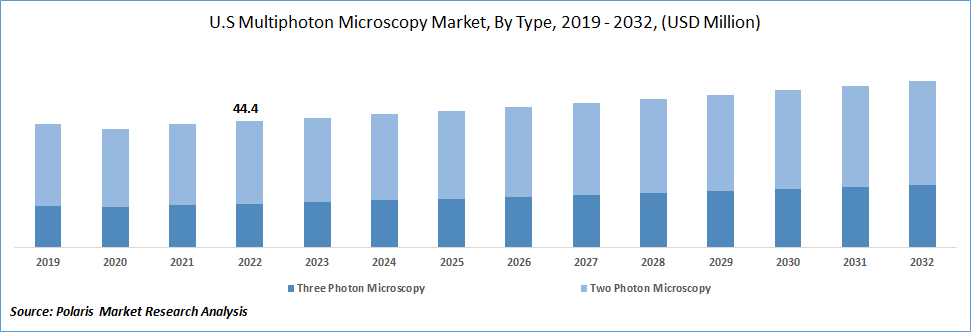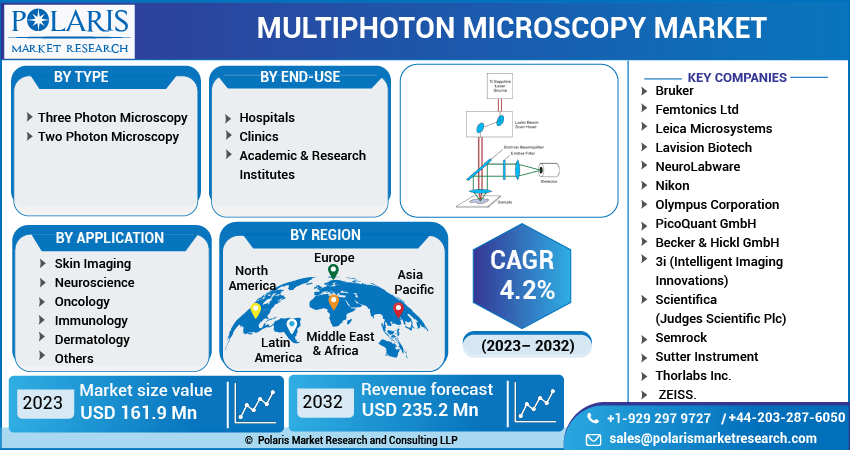
Multiphoton Microscopy Market Share, Size, Trends, Industry Analysis Report, By Type (Three Photon Microscopy, Two Photon Microscopy); By Application; By End-Use; By Region; Segment Forecast, 2023 - 2032
- Published Date:May-2023
- Pages: 117
- Format: PDF
- Report ID: PM2590
- Base Year: 2022
- Historical Data: 2019-2021
Report Outlook
The global multiphoton microscopy market was valued at USD 155.5 million in 2022 and is expected to grow at a CAGR of 4.2% during the forecast period. The rising incidence of various types of cancer has increased the need for early detection and treatment, leading to the growth of the multiphoton microscopy market. Multiphoton microscopy is gaining popularity due to its characteristics, such as deep tissue penetration, less light damage, and decreased out-of-focus bleaching, which makes it suitable for live cell imaging.

To Understand More About this Research: Request a Free Sample Report
The market is valuable in identifying and evaluating bladder cancer, spermatogenesis, and tissue identification in prostate cancer surgery. With the help of the multiphoton microscopy technique, materials with quantifiable nonlinear optical responses, such as Second Harmonic Generation (SHG), Third Harmonic Generation (THG), or fluorescence induced by multiphoton absorption, can be mapped in three dimensions. Multiphoton microscopy provides a useful method of viewing the nonlinear microscopic world with high resolution in 3-D.
The biological development of multiphoton microscopy is ongoing, focusing on deep tissue imaging, neurosciences, cancer detection, structural characterizations, protein quantification, and localization, as well as other applications. This technique is useful in identifying and diagnosing various diseases, including cancer, by providing high-resolution images of deep tissues that are not easily accessible by traditional microscopy methods.
Multiphoton microscopy is a valuable cancer detection and treatment tool, especially in identifying early-stage tumors. Its ability to penetrate deep tissues and provide high-resolution images enables researchers and clinicians to study the structure and behavior of cancer cells in real time, allowing for the development of more effective treatments.
In addition to cancer research, multiphoton microscopy is also being used in neuroscience research to study the structure and function of the brain, as well as in structural biology to determine the structures of proteins and other macromolecules. Its application in these areas has the potential to lead to significant breakthroughs in understanding the underlying mechanisms of disease and developing new treatments.
The COVID-19 pandemic has disrupted the market, causing delays in research projects due to laboratory closures and remote working. However, the pandemic has also emphasized the need for early disease detection and treatment, increasing demand for technologies such as multiphoton microscopy, which can provide high-resolution tissue images.
Additionally, the pandemic has led to increased telemedicine and remote diagnostics, where multiphoton microscopy can provide real-time images of tissues, enabling accurate diagnoses and treatment decisions remotely. Furthermore, the pandemic has increased funding for research and development, including multiphoton microscopy, to combat the pandemic and other diseases.

For Specific Research Requirements, Request for a Customized Report
Industry Dynamics
Growth Drivers
The multiphoton microscopy market is expected to experience significant growth due to an increasing prevalence of chronic diseases such as cancer, neurological disorders, and cardiovascular diseases, which require early detection and treatment. Multiphoton microscopy can provide high-resolution images of tissues, enabling accurate diagnosis of these diseases. This has led to a growing demand for multiphoton microscopy in the medical field, as it can improve patient outcomes by promoting early diagnosis and treatment.
In addition, there have been significant technological advancements in multiphoton microscopy, including developing new imaging techniques and introducing more efficient and high-performance systems. These advancements have improved the accuracy and resolution of images obtained through multiphoton microscopy, making it a more valuable tool in medical research and diagnosis. The increasing capabilities of multiphoton microscopy are expected to drive its adoption in various fields, including biomedicine, materials science, and nanotechnology.
Furthermore, the rising adoption of multiphoton microscopy in life sciences research, particularly in neuroscience, immunology, and cell biology, is expected to contribute to the market's growth. Multiphoton microscopy allows researchers to study biological processes at a cellular level, providing insights into the fundamental mechanisms of life. This has led to increased investment in research and development of multiphoton microscopy by governments, private organizations, and academic institutions, which is expected to drive the market's growth further.
Report Segmentation
The market is primarily segmented based on type, application, end-use, and region.
|
By Type |
By Application |
By End-Use |
By Region |
|
|
|
|
To Understand the Scope of this Report: Speak to Analyst
Two-photon microscopy segment dominated the market with largest share in 2022
Two-photon microscopy segment has dominated the market with the largest share and likely to continue its dominance over the forecast period. It is preferred over other techniques because it can perform photochemistry, high-resolution depth imaging, and reduce photo-toxicity. It is commonly used in studying immune cell architecture, lymphocytes, and embryonic development. The market's growth is fueled by increasing emphasis on nanotechnology and favorable government policies.
Additionally, technical advancements such as super-resolution microscopy contribute to the growing demand for two-photon microscopy. Moreover, the market is expected to expand as investments in research and development activities increase.
Skin imaging segment is projected to hold the highest revenue shares in the market
The skin imaging segment is anticipated to hold the highest revenue share market. With the growing prevalence of skin conditions, the introduction of pharmacological therapies for skin disorders, and the increasing demand for non-invasive and minimally invasive diagnostic tools, multiphoton microscopy in skin imaging is becoming more critical. The high-resolution imaging capability of multiphoton microscopy enables the accurate diagnosis and monitoring of skin conditions, providing clinicians with better insights into disease progression and treatment outcomes.
In addition, the oncology segment is anticipated to hold significant CAGR during the forecast period, with multiphoton microscopy used in accurately diagnosing prostate cancer. The technique allows for high-resolution tumor growth and metastasis imaging, providing critical information for developing effective treatment plans.
Hospitals segment holds the largest shares in 2022
The hospitals segment holds the largest share of the market and is expected to continue leading the growth over the forecast period. This can be attributed to increasing hospital budgets, the rise in new clinics, and collaborations between hospitals and medical companies to provide advanced imaging technology for better healthcare infrastructure post-COVID-19.
Furthermore, academic and research institutes are developing laser technology to examine skin cancer cells and creating advanced microscopy techniques to improve skin and cell imaging results. The collaborations between universities and industry players drive the development of new and sophisticated microscopy techniques that benefit med-tech advancements.
North America dominated the global market in 2022
North America dominates the global market, driven by the region's high investment in developing novel microscopy technologies. The United States, in particular, is a key market for multiphoton tomography, with many clinics utilizing this technique. The rising incidence of cancer in the U.S. is also expected to drive demand for multiphoton microscopy, as it is the country's second leading cause of death.
Asia Pacific region is expected to hold highest CAGR over the forecast period. In the Asia Pacific region, countries such as China, Japan, India, Australia, and South Korea register higher revenues in the market due to significant investments in oncology, neuroscience, and other sectors that boost consumer demand.
India, in particular, is promoting investments to support startups in the neuroscience sector, which is expected to drive the market further. With the continued growth of these markets and the increasing demand for advanced diagnostic tools, the global multiphoton microscopy market is poised for a significant increase in the coming years.
Competitive Insight
Some of the major players operating in the global market include Bruker, Femtonics Ltd, Leica Microsystems, Lavision Biotech, NeuroLabware, Nikon, Olympus Corporation, PicoQuant GmbH, Becker & Hickl GmbH, 3i (Intelligent Imaging Innovations), Scientifica (Judges Scientific Plc), Semrock, Sutter Instrument, Thorlabs Inc., and ZEISS.
Recent Developments
- In March 2022: The Ultima Investigator Plus, a brand-new modular platform for the Ultima range of multiphoton microscopes for deep tissue fluorescence imaging, was released by Bruker.
- In December 2021: The AX R MP multiphoton confocal microscope, developed by Nikon Instruments Inc., a pioneer in high-tech microscope systems, has been made available. It can quickly and efficiently capture images with a large field of view, high resolution, and high speed deep inside living things.
Multiphoton Microscopy Market Report Scope
|
Report Attributes |
Details |
|
Market size value in 2023 |
USD 161.9 million |
|
Revenue forecast in 2032 |
USD 235.2 million |
|
CAGR |
4.2% from 2023 – 2032 |
|
Base year |
2022 |
|
Historical data |
2019 – 2021 |
|
Forecast period |
2023 – 2032 |
|
Quantitative units |
Revenue in USD million and CAGR from 2023 to 2032 |
|
Segments Covered |
By Type, By Application, By End-Use, By Region |
|
Regional scope |
North America, Europe, Asia Pacific, Latin America; Middle East & Africa |
|
Key Companies |
Bruker, Femtonics Ltd, Leica Microsystems, Lavision Biotech, NeuroLabware, Nikon, Olympus Corporation, PicoQuant GmbH, Becker & Hickl GmbH, 3i (Intelligent Imaging Innovations), Scientifica (Judges Scientific Plc), Semrock, Sutter Instrument, Thorlabs Inc., and ZEISS. |
FAQ's
key companies in multiphoton microscopy market are Bruker, Femtonics Ltd, Leica Microsystems, Lavision Biotech, NeuroLabware, Nikon, Olympus Corporation, PicoQuant GmbH, Becker & Hickl GmbH.
The global multiphoton microscopy market expected to grow at a CAGR of 4.2% during the forecast period.
The multiphoton microscopy market report covering key segments are type, application, end-use, and region.
key driving factors in multiphoton microscopy market are rising Focus on Nanotechnology.
The global multiphoton microscopy market size is expected to reach USD 235.2 million by 2032.
